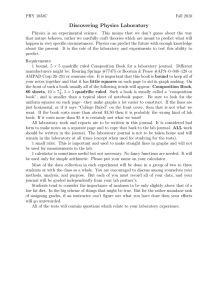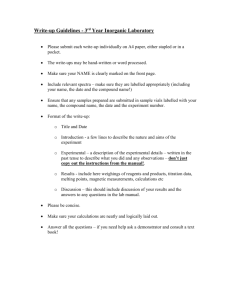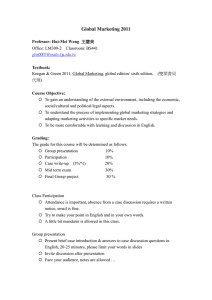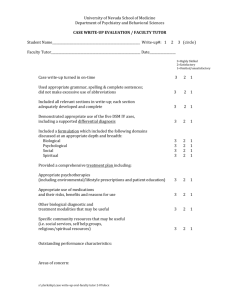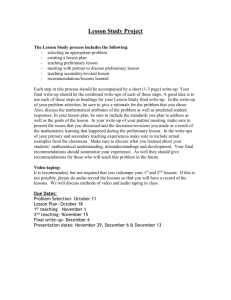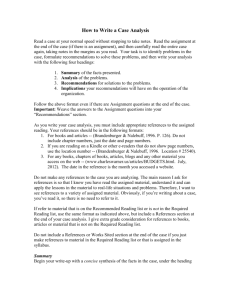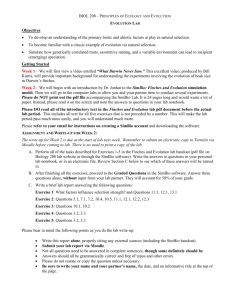Discovering Physics Laboratory
advertisement
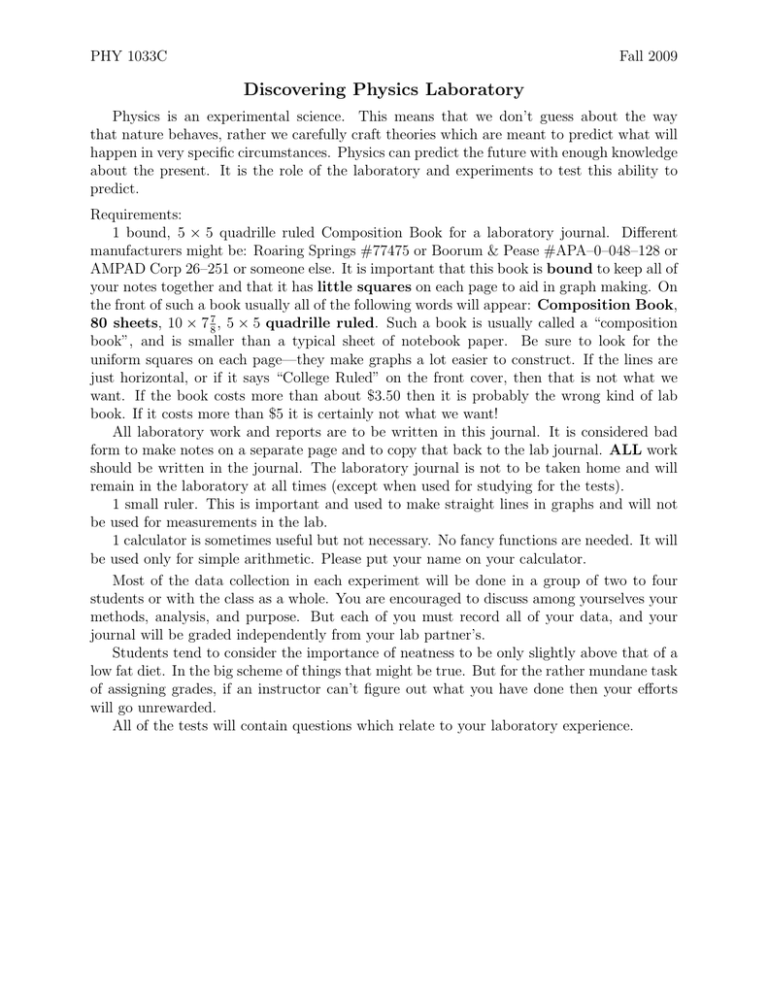
PHY 1033C Fall 2009 Discovering Physics Laboratory Physics is an experimental science. This means that we don’t guess about the way that nature behaves, rather we carefully craft theories which are meant to predict what will happen in very specific circumstances. Physics can predict the future with enough knowledge about the present. It is the role of the laboratory and experiments to test this ability to predict. Requirements: 1 bound, 5 × 5 quadrille ruled Composition Book for a laboratory journal. Different manufacturers might be: Roaring Springs #77475 or Boorum & Pease #APA–0–048–128 or AMPAD Corp 26–251 or someone else. It is important that this book is bound to keep all of your notes together and that it has little squares on each page to aid in graph making. On the front of such a book usually all of the following words will appear: Composition Book, 80 sheets, 10 × 7 87 , 5 × 5 quadrille ruled. Such a book is usually called a “composition book”, and is smaller than a typical sheet of notebook paper. Be sure to look for the uniform squares on each page—they make graphs a lot easier to construct. If the lines are just horizontal, or if it says “College Ruled” on the front cover, then that is not what we want. If the book costs more than about $3.50 then it is probably the wrong kind of lab book. If it costs more than $5 it is certainly not what we want! All laboratory work and reports are to be written in this journal. It is considered bad form to make notes on a separate page and to copy that back to the lab journal. ALL work should be written in the journal. The laboratory journal is not to be taken home and will remain in the laboratory at all times (except when used for studying for the tests). 1 small ruler. This is important and used to make straight lines in graphs and will not be used for measurements in the lab. 1 calculator is sometimes useful but not necessary. No fancy functions are needed. It will be used only for simple arithmetic. Please put your name on your calculator. Most of the data collection in each experiment will be done in a group of two to four students or with the class as a whole. You are encouraged to discuss among yourselves your methods, analysis, and purpose. But each of you must record all of your data, and your journal will be graded independently from your lab partner’s. Students tend to consider the importance of neatness to be only slightly above that of a low fat diet. In the big scheme of things that might be true. But for the rather mundane task of assigning grades, if an instructor can’t figure out what you have done then your efforts will go unrewarded. All of the tests will contain questions which relate to your laboratory experience. Lab write-up’s The following minimum structure is required for each laboratory write-up and for the proper upkeep of your laboratory journal. 1. Each experiment should have a title, a date, and a list of the names of all of your laboratory partners (including last names). 2. There should be a few sentences which describe the purpose of the experiment. 3. There should be enough description of what you actually do that someone unfamiliar with the lab and the lab handout, but familiar with physics, can read your report and understand what you did. A labeled diagram is often helpful. 4. Data that is taken should be entered neatly in your journal. Nice columns, made with your ruler, look good. Any measurement that you make has some unit associated with it. If there is a number in your book it should be clear what your units are and what the number means. It is always a good idea to repeat any measurement you make to get an idea about how accurate it is. 5. The data analysis is the comparison of your measurements with the predictions of the laws of physics. If it is appropriate (and it usually is), then a simple graph of your data should be made. Make the graph big, label the axes and the tick marks, include units, give a title to the graph, and use your ruler for the axes. 5. Answer all questions in the lab handout. It is important that your answers be in the form of declarative sentence—just a plane statement of a fact. If I’m reading your write-up then I should understand what you are writing about without looking at the lab handout. 6. The conclusion should summarize what you have learned or demonstrated in the laboratory. Sometimes the results are surprising—this should be noted and explained, if possible. Sometimes the results are just what is expected—this should also be noted and explained. The handout for each laboratory is meant as your guide. To have a worthwhile experience you must actually understand both why and what you are doing. Hence, you will need to fill in most of the details yourself. If you read the handout before the laboratory and think about it a bit, then one fifty minute period should be ample to complete both the data collection as well as the analysis. In general, care and precision in a laboratory measurement is important. But if I really wanted to know the speed of light then I would look it up in some book; I would not ask you to measure it for me in the lab. The purpose of an experiment is not just to measure the value of an important number in nature; but, rather, it is to show you how to measure the important number (and often the task is much easier than might have been anticipated). In physics, clarity of thought and expression is paramount. These rules for the write-ups are meant to aid in attaining the nirvana that accompanies such goals and are neither as rigid nor as important as they may sound. Rather they are hints and guidelines which will help you record and understand what you are doing. Grading: For a single laboratory, the maximum grade is 10. Including a skeleton description and all of the above details is worth 6 points. Including correct answers (in sentences) to all of the questions in the write-up as well as a correct conclusion raises the grade to 8 points. A rich description and conclusion, perhaps including your own observations and examples, or bringing in material from class might raise the grade to 10 points. All questions about grades on a laboratory write-up must be resolved before the subsequent laboratory is finished.
